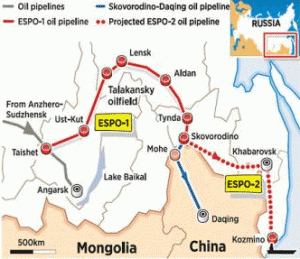According to the data provided by "Transneft" ESPO-2 annual capacity may be increased to 80 million tons by 2020. Consumption of East Siberian crude will be diversified: the American market will receive 35 percent of Kozmino oil, around 30 percent will go to Japan and 28 percent to China. The rest will go to Singapore, Malaysia and South Korea. The Vankor oil field controlled by Russian company "Rosneft" will be the main contributor of oil to the pipeline. "There is just enough East Siberian oil for the existing pipeline," -- concluded "Sberbank Asset Management" energy analyst Valery Nesterov, evaluating economic prospects of the project.

ESPO-2 Pipeline
(Image by routemag.com/2013/01/27/geopolitical-and-economic-impact-of-epo-2-pipeline/) Details DMCA
ESPO-2 Pipeline by http://routemag.com/2013/01/27/geopolitical-and-economic-impact-of-epo-2-pipeline/
The ESPO-2 pipeline completion has created a new energy system in Eastern Eurasia. Its industrial potential is immense, because East Siberia oil fields are still underexplored and reservoir volumes are very promising. Production and refining centers will be built in the Krasnoyarsk region. Even the Arctic shelf will be explored. Russian energy companies consider ESPO-2 pipeline to be the key element of the strategy for economic development of this region. Forced industrial development of this new frontier market will create jobs, spur economic growth and attract investors. It may become a "new Saudi Arabia" for those, who understand the risks of instability emerged from the U.S. interventions in the Middle East.
Placing ESPO-2 pipeline in operation will open new opportunities for Russian energy sector. Under no circumstances it should be interpreted as a political leverage of any sort, as the EU is Russia's largest trading partner by far. However, strategic flexibility of Russian energy policy can to some extent limit the EU attempts to dictate contract terms to Moscow or treat Russian companies as unequal partners. Aggressive lobbying of the so-called "third energy package" by some of the EU member states has no business perspective now. Or as the CEO of Transneft has put it: "If the EU nations want to hold a normal, proper conversation, they should change their approach to such a dialogue". Partial reorientation of Russian exports to the East is only a matter of time: combined share of Asian countries in total Russian oil exports will rise to approximately 35% by 2015.
The Eastern Siberian crude, a new oil blend, will also have serious impact on the world energy market. It is relatively light and contains less sulfur than, for example, the Dubai blend. "It's a better quality crude than Dubai, Oman and some of the other competing crudes and that means that overtime the market should resolve that issue", -- said Jason Feer, Senior Vice president at Argus Media. This crude product has every chance of becoming a new benchmark and an important economic factor. The ESPO-2 blend is already traded with a $1 -- $1.5 premium to Urals crude, Russia's main export blend.
Finally, bilateral trade turnover between Russia and China will continue to grow. According to the contract for 20 years, the ESPO-2 is to provide China with 15 million tons of crude oil a year. Both sides express interest in long-term economic cooperation. On January 14 the Russian oil company "Rosneft" has invited China's state-owned energy giant CNPC to discuss a potential increase in oil supplies via the Atasu-Alashankou section of the Kazakhstan-China pipeline linking Atasu in Central Kazakhstan to Alashankou (Alataw Shankou) in China's northwestern Xinjiang Uygur autonomous region. Preliminary talks are reported to be successful: earlier in 2012 Kazakhstan reduced transit tariffs for Russian crude shipments and the Chinese got the discount on oil they wanted. One of the possible outcomes of these negotiations will be the overall increase of the export volume of Russian oil to China.
Developing Chinese economy needs this stable energy source to overcome macroeconomic instability. China is still the second-largest consumer of oil after the United States. The International Energy Agency estimates that China's consumption will grow to 13.1 mbd (million barrels per day) in 2030, up from 3.5 mbd in 2006. Oil has played a key role in powering the 9 percent growth its economy has seen every year for the past two decades, reminds "The Telegraph".
Chinese interest in Russian oil can be easily explained, if we look at the map of the Middle East and North Africa. Today, 58% of China's oil imports come from this region. The U.S. and its allies provoke riots and instigate civil wars to justify military interventions in oil-producing countries to establish control over resources. Aggressive foreign policy of the U.S. in the Middle East undermines security of oil supplies, but energy is vital for overcoming the slowdown in Chinese industry. To China, Russian exports provide insurance against volatility on the unstable Arab oil market. Russia in its turn may use Chinese investments to create industrial cluster in Eastern Eurasia. Given the fact that in 2012 these countries started using national currencies in bilateral trade, this slow process may become the first step towards breaking the Western monopoly on international energy policy. It will hopefully lay the foundation of a fairer multipolar global order.





